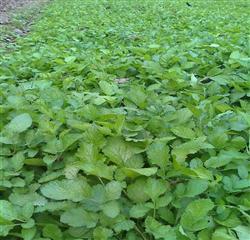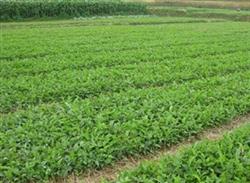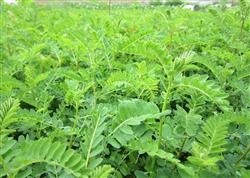How to grow Radix Salviae Miltiorrhizae?

How to grow Radix Salviae Miltiorrhizae? How many planting methods are there for Salvia miltiorrhiza? Salvia miltiorrhiza is a perennial herb salvia miltiorrhiza (SaLviamiltiorrhiza,Bge) of Labiatae. Xi said: blood ginseng, purple salvia miltiorrhiza, red root and so on. Salvia miltiorrhiza has strong adaptability, like warm, humid, sunny environment, cold tolerance, shade tolerance, drought and waterlogging tolerance. When the temperature is below 3 ℃, the physiological activity is relatively weak, the growth is extremely slow, sprouting above 5 ℃, growing rapidly above 16 ℃, and the whole annual growth period is about 220 days. In a normal year, the growth cycle is 1 / 2 years. Annual Salvia miltiorrhiza, about 500kg per mu of Salvia miltiorrhiza (dry goods), according to 8 yuan / kg market price (current market price 12 yuan / kg), annual income per mu is 4000 yuan. 1. Land selection and soil preparation (1) Salvia miltiorrhiza does not have strict requirements on soil, but in order to achieve high yield and high quality, it is better to choose loam or sandy loam with deep soil layer, loose soil, rich organic matter and good drainage. Nursery land is best selected flat, easy to drainage and irrigation, tillage layer deep and fertile slightly acidic sandy loam or loam. (2) before winter, the soil preparation should apply rotten farm manure 1000kg, nitrogen, phosphorus and potassium ternary compound fertilizer 25kg, deep ploughing 30-50cm, raking fine and leveling, and every 1m area, raise the ridge of 30cm-50cm. If the seedling is raised by seed root, the width of the whole border is 1-1.5m, and the length is determined according to the amount of seed root. Second, the propagation method of Radix Salviae Miltiorrhizae mainly adopts root division, cutting and seed propagation. Root division and seed propagation are often used in production. In order to obtain high yield, root division propagation should be adopted. (1) split-root propagation method: 1. Select the root and treat the Beginning of Winter with Salvia miltiorrhiza, select the coarse red root strip with a diameter of 0.5-1cm, cut it down from the base of the stem, cut down the stem base in turn, and each segment is 8-10cm long. It is best to use only the two segments depending on the root head, arranged according to its natural growth order, with the top facing up. Then use straw rope to bind into moderate bundles (200 trees, 300 plants), dig a suitable cellar, cover the bottom of the cellar with a layer of wet soil, put the tied roots on top, still keep the top tightly lined up, after the row is full, sprinkle a layer of wheat bran (about 10cm thick) on top, then sprinkle a layer of wet soil (about 3cm thick) on the top, then arrange the roots, cover the top with a layer of wheat bran, and seal the cellar. There should be a gap of about one foot between the top of the cellar and the root to keep warm. 2. After raising seedlings in a small arch shed in spring, take out the roots in the cellar, choose the place to take shelter from the wind and the sun to make the border 1-1.5m wide, the length is appropriate, prepare the ground, cover with mature soil and miscellaneous fertilizer, the ratio of fertilizer to soil is 1:1, and apply urea 3-5kg per mu. Then put the seed roots side by side into the border to maintain a certain slope and gap, sprinkle the top and the gap with mixed fertilizer soil, cover the top with a layer of fine sand (1-1.5cm thick), make an arch shed with fine bamboo poles or tree strips on the border, wet it with 45-50 ℃ of water, cover the film quickly, compact it with soil around, cover it with grass at night, remove it during the day, and wait for more than 80% to sprout. The two-stage ventilation seedlings of the film can be opened at noon and can be transplanted in the field after 3 Mel for 5 days. 3. The time of transplanting in the field is from February to mid-March in early spring, that is, stinging and the Spring Equinox are the best. 4, transplanting density on the whole planting land, according to the row spacing of 30-35cm meters, plant spacing of 15-20cm, 8000 trees per mu, digging holes deep in 8-10cm, the seedlings are placed at an angle of 30-10cm 45 degrees with the top up, and the soil is about 3cm after planting. Compaction, in order to ensure the whole seedling, you can first water, wait for the water to seep, and then plant the seedlings. (2) seed propagation method 1. The best time for raising seedlings is August, that is, July and August of the lunar calendar. 2. Seed breeding method: first dry the seeds for one day, then soak the seeds in 45 Mel 50 ℃ warm water for 3 minutes, then soak them in warm water for 24 hours, spread them evenly on the seedling ridge, use 4 kg seeds per mu, gently hug them with 10-toothed rakes, then pat them with a shovel or firmly with feet, cover them with 1 finger thick short wheat straw, and spray them through with water. 3. The seedbed management sprays water regularly to prevent the land from cracking, and control watering after emergence. When the seedling grows to 4 leaves, gently use bamboo rake to remove wheat straw in cloudy or sunny evening, and remove weeds and seedlings in time. 4. The transplanting time in the field can be transplanted from November of that year to February of the next year. 5. Transplanting density on the whole planting ridge, according to row spacing 30-35cm, plant spacing 15-20cm, 8000 trees per 666 square meters, dig 12 000 plants, dig 10-15cm deep holes, pour water first, wait for water to seep dry, then plant seedlings, seal, the head can not be exposed to the ground, in dry years, can be irrigated with small water or secretly watered in the roots to protect the seedlings. Third, field management (1) ploughing and weeding after transplanting in early spring to prevent running soil moisture and increase soil temperature, paddling hoe can be carried out, but it should not be too deep. Intertillage and weeding should be carried out in May, June and August respectively. (2) Bud picking in order to promote root development and increase yield of Salvia miltiorrhiza, buds should be picked in time throughout the flowering period, and do not wait for flowering before picking. (3) for those who apply topdressing base fertilizer, they can apply rotten cake fertilizer or ternary compound fertilizer 10-15kg in the middle stage of field management, depending on the growth of Salvia miltiorrhiza. (4) in the rainy season of drainage and irrigation, stagnant water should be removed in time to prevent rotting roots, and when the seedling stage and soil is dry, it should be watered in time, and ploughed and loosened in time after watering. 4. Prevention and control of diseases and insect pests (1) the common diseases are root rot, which is easy to occur in high temperature and rainy season and continuous cropping land, the aboveground growth of the diseased plant is not flourishing, the stems and leaves are yellow and thin, and the roots are black. Prevention and control methods: (1) ridge cultivation, timely drainage after rain; (2) rotation and stubble adjustment; (3) 1000 times of carbendazim or stone-sulfur mixture during the disease period. (2) the main pests are aphids, racemose moths, grubs and ground tigers. (1) Control aphids: plant ash can be used to spread after rain or before the dew disappears in the morning. (2) Prevention and control of Spodoptera litura: Baibu of traditional Chinese medicine can be used and sprayed with 0.5 kg decoction and water per mu. (3) Control of underground pests: when planting, phoxim or trichlorfon, mixed with poison bait, are poisoned in the ditch. Harvest and processing (1) harvesting 1. Harvest time after planting of Salvia miltiorrhiza before and after the Beginning of Winter in the same year and before sprouting in the spring of the following year are the best harvest time. 2. Harvest method on a sunny day, Shunlong uses tools such as bristles to carefully dig out all the roots, remove the halter and shake off the soil. (2) the planed Salvia miltiorrhiza can be dried by processing method, and washing and rain are prohibited. 6. seed retention technology is often used in the production of seed retention and seed root production. (1) the remaining seed method can blossom and bear seeds in the same year, but it blossoms less in the first year and the seed setting rate is lower, so it is generally not allowed to blossom and bear seeds. Generally speaking, Salvia miltiorrhiza is better than Salvia miltiorrhiza in the second year after seedling transplanting. Seedling transplanting Salvia miltiorrhiza grows in the second year, it can produce 20ml / mu of Salvia miltiorrhiza seed, it can bear seed 2mi 3 times in a year, Salvia miltiorrhiza belongs to infinite fruiting habit, the lower part of Salvia miltiorrhiza belongs to infinite fruiting habit, the lower part of Salvia miltiorrhiza is matured first, and it is impossible to mature all of it, so after most of it is mature in the middle, it can be picked, dried in the sun, and then selected by water or air to leave full seeds, and the mature seeds are brown to black. (2) the method of keeping seed root when planting before the Beginning of Winter or before germination, Salvia miltiorrhiza with strong growth, full development and disease-free insect free was selected. Choose one-year-old lateral root with a diameter of about 1 cm, stout and full, bright red in color and no decay as seed root, but not hollow old root or poor growth fine root. Remove the Reed head and thin tail from the selected root strips, cut them down along the stem base, and each section is 8-10cm long. It is best to choose only the two segments that depend on the root head, which can be hidden in winter, or can be planted in spring, cut and put in a ventilated and dry place for half a day to be planted. This product is cylindrical, the surface is bright red to reddish brown, hard and brittle, easy to break, the cross section is flat, milky white, powdery, fragrant, slightly sweet and astringent taste. 7. Packaging, storage and transportation (1) before packaging, Salvia miltiorrhiza should check whether it is sufficiently dry, whether there are impurities and other foreign bodies, and the packaging used shall conform to the standards of medicinal packaging, and each package shall be marked with the product name, specification, place of origin, batch number, implementation standard, production unit, production date, etc., together with a mark of qualified quality. (2) the stored and processed Salvia miltiorrhiza should be stored in a dry warehouse, and should be protected against insect, rat, moisture and mildew, and can be stored in a low-temperature warehouse in summer. (3) the means of transport or containers should have good ventilation conditions to keep them dry, and should not be mixed with other toxic, harmful and easy-to-taste substances. Click to get more planting techniques of Salvia miltiorrhiza
- Prev

How to raise seedlings and propagate Salvia miltiorrhiza?
How to raise seedlings and propagate Salvia miltiorrhiza? Please introduce several propagation methods of Salvia miltiorrhiza, such as seed seedling method, plant division method, root division method and cutting method, etc. The root-splitting method is mainly used in production, and this method can greatly increase the output. (1) split root method: select robust, disease-free insect, thick 0.
- Next

How to apply fertilizer and prevent pests when planting Astragalus membranaceus?
How to apply fertilizer and prevent pests when planting Astragalus membranaceus? Please help introduce the method of Astragalus fertilization and insect pests can refer to the following methods: first, fertilization management. Astragalus is more fond of fertilizer, and it needs topdressing 2 Mel 3 times a year on the basis of sufficient base fertilizer. After the first time Miao Qi or turn green, apply farm manure; after the second time ploughing and weeding, topdressing circle.
Related
- Fuxing push coffee new agricultural production and marketing class: lack of small-scale processing plants
- Jujube rice field leisure farm deep ploughing Yilan for five years to create a space for organic food and play
- Nongyu Farm-A trial of organic papaya for brave women with advanced technology
- Four points for attention in the prevention and control of diseases and insect pests of edible fungi
- How to add nutrient solution to Edible Fungi
- Is there any good way to control edible fungus mites?
- Open Inoculation Technology of Edible Fungi
- Is there any clever way to use fertilizer for edible fungus in winter?
- What agents are used to kill the pathogens of edible fungi in the mushroom shed?
- Rapid drying of Edible Fungi

